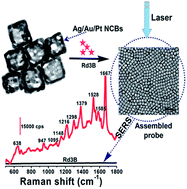Novel Ag/Au/Pt trimetallic nanocages used with surface-enhanced Raman scattering for trace fluorescent dye detection†
Abstract
Trimetallic nanostructures have received considerable attention in recent years, due to their widespread use in photonics, catalysis, and surface-enhanced Raman scattering (SERS) detection. Nanoparticles consisting of multiple (n ≥ 3) noble metal components, synthesized under controlled conditions, show better SERS-active stability than mono- or bimetallic nanoparticles. In this work, a simple and novel protocol was used for the synthesis of hollow or porous Ag/Au/Pt trimetallic nanocages, based on a galvanic replacement reaction and co-reduction of the corresponding ions. The nanocages were characterized by UV-vis spectroscopy, transmission electron microscopy (TEM), high-resolution TEM, and X-ray diffraction. It was also demonstrated that the Ag/Au/Pt trimetallic nanocages were both extremely SERS-active and stable. Our results show that Rhodamine 3B, used as a fluorescent marker, could be detected over a wide concentration range from 10−15 to 10−8 M, with the lower limit of detection being 10−15 M.


 Please wait while we load your content...
Please wait while we load your content...